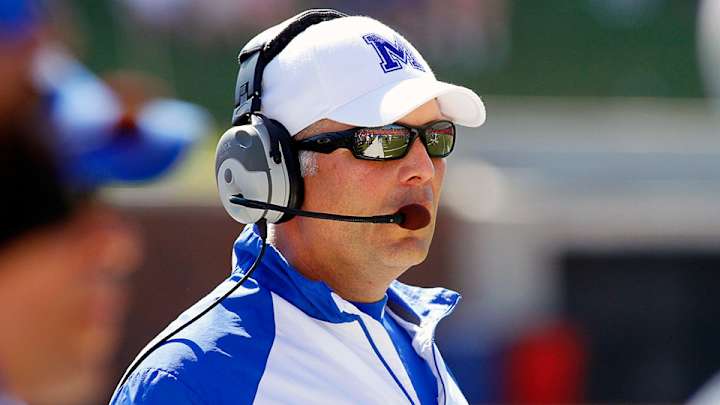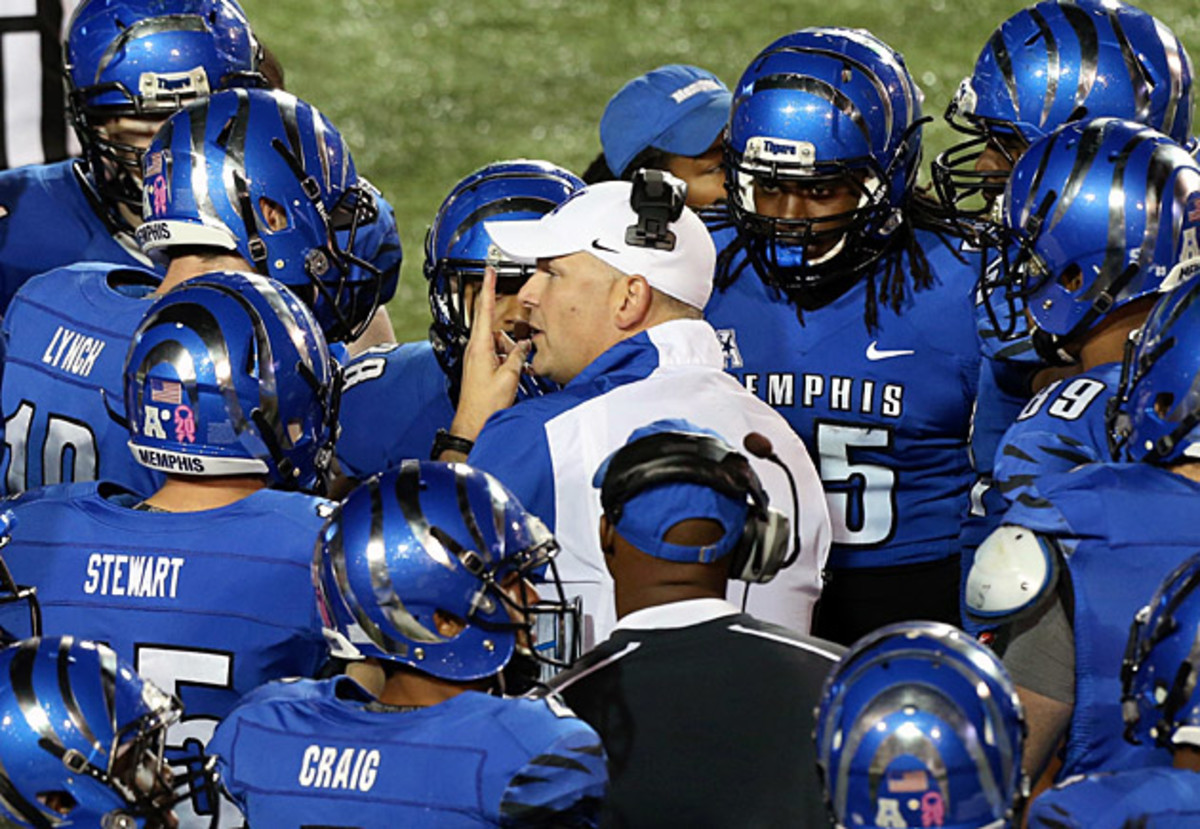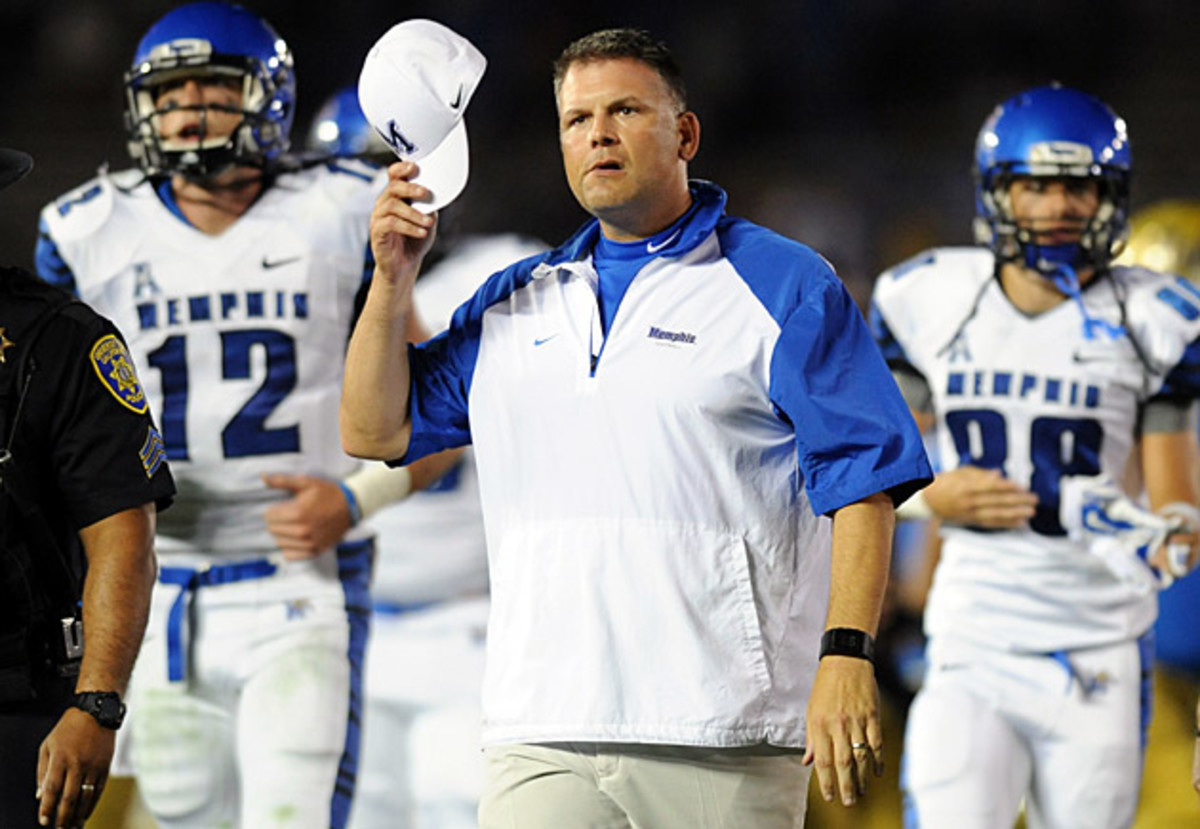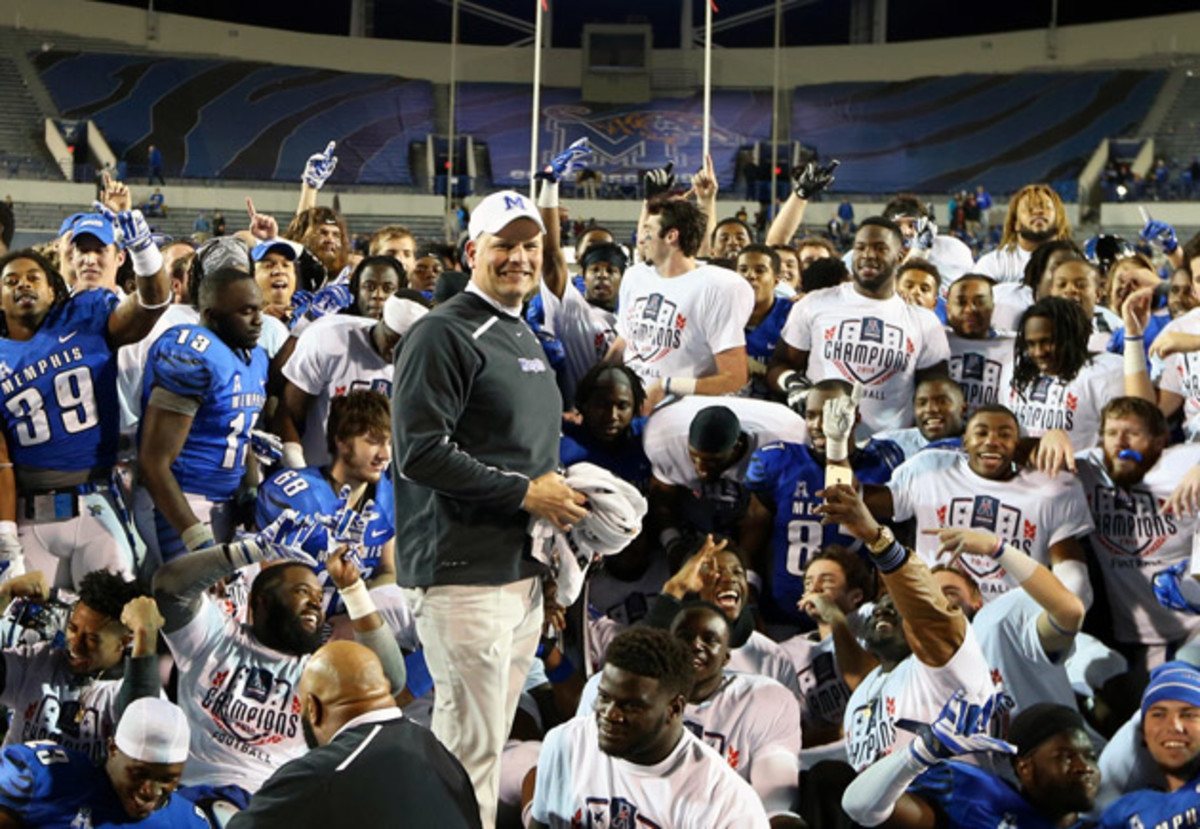College football's next hot coach: The rise of Justin Fuente at Memphis

Charles Harris sat and waited, because that’s all he could do. A lot went through his mind on that night in December 2011. After all, this wasn’t part of Harris’ plan. The Memphis freshman linebacker wasn’t supposed to be in the school’s Billy J. Murphy Athletic Complex, tucked inside a spacious meeting room, as the Tigers prepared to come face-to-face with their new coach.
Yet Harris couldn’t ignore the reality of his situation: Two weeks earlier the school had fired coach Larry Porter following a dismal 2-10 season. Harris had signed with Porter the previous February out of nearby Whitehaven (Tenn.) High, which sits just 13 miles from the Memphis campus. He had spurned offers from Northern Illinois and Arkansas State to stay home and resurrect a program that went 1-11 in 2010. But as he sat with his teammates, that dream seemed all but over.
At around 9 p.m. Justin Fuente entered the room. He had spent much of the day glad-handing boosters and speaking with the media. If he enjoyed his exercise in politicking, it didn’t show. That’s what Harris remembers most from his first encounter with his new coach. “He walked into the meeting room with a pissed-off look on his face,” Harris said. “Then he said, maybe, three sentences to us.”
Ohio State, TCU, Auburn lead Way-Too-Early College Football Top 25
Fuente’s message was brief, but telling. He told his players to enjoy Christmas break, because they’d get to work when they returned. Then he walked out.
“We were like, ‘Wow, that was it, man?’” Harris said. “’That’s all you’re going to say to us?’ But three years later, I’ve learned coach Fuente is good at getting his point across when he’s pissed off.”
Three years later Harris has also realized Fuente’s arrival was the best thing that could have happened to his career. Last month the Tigers capped their second 10-win season in school history with a 55-48 victory over BYU in the Miami Beach Bowl. Once a conference doormat, Memphis clinched its first league title since 1971, winning seven more games than it did in 2013.
Now Fuente is one of the hottest names in college coaching. When he arrived at Memphis, the football team was in tatters. But over the span of three seasons a coach with Oklahoma roots and a BCS pedigree has turned around a program many considered beyond repair. And Fuente says he isn’t finished.
“People around here always ask me if they’re going be overwhelmed by all of this, because they just haven’t had much success,” Fuente said. “My answer is that our kids have always been very good listeners. They’ve listened to our message week-in and week-out, and as a whole throughout the season. The things that we’ve tried to teach, they’ve really tried to do.”
*****

Fuente caught the football bug as a grade-schooler in his hometown of Tulsa, Okla., where the sport was a way of life. But his father, Jim, a stockbroker, was hesitant about sending Justin into the fires of a contact sport too soon. So, Justin took matters into his own hands. In fifth grade he convinced his father to attend a youth football game. “After he watched the game he was like, ‘OK, you can play,’” Justin said. “He realized no one’s getting hurt out there.”
A year later Fuente suited up for his first season on the gridiron. He had hoped to become a tight end, but Fuente’s youth coach saw him throwing balls on the sideline one day before practice. He switched Fuente to quarterback on the spot. Fuente initially questioned the move, but the position quickly grew on him. By 1992, his sophomore year at Union (Okla.) High, he was brimming with talent.
Union was also looking for a coach prior to the 1992 season. Administrators zeroed in on Bill Blankenship, then at Edmond Memorial (Okla.) High, which sits about 100 miles southwest of Tulsa. Blankenship was fresh off two state playoff berths. More importantly, he was known for his passing attack, and a potential pairing between Blankenship and Fuente intrigued the school’s higher-ups.
Way-Too-Early 2015 Heisman Watch: TCU's Trevone Boykin leads the pack
“In a lot of ways, [Fuente’s] ability as a throwing quarterback probably helped me get the job,” said Blankenship, who eventually became the head coach at Tulsa in 2011 before being fired after a four-year stint last December. “That kind of got my foot in the door a little bit because they believed they had a hot young quarterback who could take them a long way. That really worked out well for me.”
Soon after Blankenship arrived at Union, two quarterbacks listed ahead of Fuente on the depth chart -- a junior and a senior -- marched into the coach’s office and asked to change positions. Everyone knew Fuente embodied the program’s future.
Blankenship formed a fast bond with Fuente, who was coachable almost to a fault. The quarterback was like a sponge; Blankenship had to be careful with what he told him, as the young player would take every word as gospel. “He’d say ‘But I thought you said…’ and I’d have to say ‘Well, I didn’t mean that against every defense,’ Blankenship said.
Fuente developed into one of the premier quarterbacks in the state. He carried Union to state playoff appearances in all three seasons as a starter. He led the state in passing yards (2,934) and touchdown passes (32) as a senior in 1994. Union finished as the Class 6A runner-up that season, and the Tulsa World selected Fuente as the state’s player of the year.
Recruitment was an interesting time for Fuente. His relatives on his father’s side went to Oklahoma State. His mother, Lynn, hailed from a family of Sooners. But a house divided didn’t sway Fuente from choosing the state’s power program. The quarterback signed with Oklahoma in the spring of 1995.
*****

Despite his dazzling high school performance, Fuente’s playing career never took off in Norman. Howard Schnellenberger, who recruited Fuente, resigned after one forgettable season with the Sooners in 1995. After two years playing under John Blake, a downtrodden Fuente transferred to Murray State in ’98 to reunite with Denver Johnson, who had worked as an Oklahoma assistant in ’96 before moving to become the Racers head coach in ’97.
When Fuente arrived at Murray State, Johnson could sense his disappointment. Fuente had hoped to emerge as the next great Oklahoma quarterback, but that dream had been dashed. “You ever see those commercials on TV where they have those abandoned animals in the shelter?” Johnson said. “He looked like one of those dogs. He just had big ol’ sad eyes.”
But Fuente made the most of his new beginning. He requested the No. 2 jersey, as Murray State represented his second chance at college football. He wore a rubber band on his wrist and smacked his arm in difficult moments to remind him of how fragile opportunities can be. Soon Fuente’s trajectory began to trend upward. He set four school records as a senior in 1999, including for single-season passing yards (3,498) and touchdowns (27). That season he was named Ohio Valley Conference Offensive Player of the Year and a Walter Payton Award finalist.
During a short stint with the Oklahoma Wranglers in the Arena League -- “I played more golf than football in the Arena League,” Fuente said -- he received a call from Johnson. His old coach wanted him to join his staff at Illinois State. Coaching had lingered in the back of the quarterback’s mind for a while, thanks to the influence of Blankenship, Johnson and the late Dick Winder. Winder, who died this December at age 73, served as offensive coordinator at Oklahoma during Fuente’s time there and was a well-known figure in Texas coaching. No individual did more to stoke the fire beneath Fuente’s future career.
The top 25 games of the 2014 season
“I wanted to be Dick Winder when I grew up,” Fuente said. “He was just this old, gruff West Texas guy that was a fantastic football coach and was really tough on his players. But his players would do anything for him. I wanted that feeling. That’s when I decided I wanted to coach.”
Fuente landed his first college job as a 25-year-old quarterbacks coach at Illinois State in 2001. He earned play-calling duties as the offensive coordinator by age 28. Before the ’07 season, Winder, who spent time as an assistant at TCU, convinced Gary Patterson to give Fuente a call. “I chose him to be our offensive coordinator over a couple other guys because I thought he was a great listener,” Patterson said. “He was a guy that would come in the room, and there was chemistry.”
TCU was already a Mountain West power when Fuente arrived as running backs coach in 2008, but his offenses helped the Horned Frogs morph into a national brand. They reached two BCS bowls during Fuente’s stint as co-coordinator, capping an unbeaten ’10 season with a win over Wisconsin in the Rose Bowl.
Fuente also helped tutor quarterback Andy Dalton, who became a second-round NFL draft pick after breaking several passing records at TCU. “He helped Andy mature,” said Jarrett Anderson, the Horned Frogs offensive line coach who served as co-offensive coordinator with Fuente. “Andy had matured a little bit, but [Justin] was trying to give him some insight on what he’d been through as a quarterback.”
Memphis hired Fuente away from TCU on Dec. 8, 2011. The Tigers had won only five games in the three seasons prior to his arrival. But he saw first-hand what it took to build a program at TCU. He said the same could be done at Memphis.
“That’s the decision that we’re trying to make,” Fuente said. “We’re going to do whatever we can to make sure we build a football program, even if we are in the middle of SEC country, just the way Forth Worth, Texas, is in the middle of Big 12 country. We want to have that work ethic and blue-collar attitude that, hopefully, people will take notice of.”
*****

Some things are tougher than resurrecting a football program. Try parenting, for example. Since he arrived in Memphis, Fuente has been working to get his 6-year-old daughter, Cecilia, hooked on golf.
“My oldest [daughter’s] attention span is so short, I can’t ever figure out if she likes it,” said Fuente, an avid golfer and father of three girls. “She likes everything. She’ll shoot basketball for five minutes and love it, but she’ll only do it for five minutes. She’ll hit a golf ball for five minutes, then she’s on to something else.”
Like selling golf to his daughter, selling the Tigers football program was high on Fuente’s list of priorities. But before focusing on the field, he had to convince his players that Memphis could win. Much of that process was mental, like installing the “Tiger Code.” It consists of three elements: fundamentally sound, physically fit and mentally tough. Fuente also formed a leadership council with a handful of key players. The council built a bridge between the coaches and the locker room.
Fuente sparked a new tradition, too: After each win, the team gathers on the edge of the Liberty Bowl and sings the fight song, “Go, Tigers! Go!” with the band.
2015 NFL draft declaration winners, losers: Which programs fared best?
Memphis went 4-8 in Fuente’s debut in 2012, a record that included a 4-4 mark in league play in the team’s last year in Conference USA. In ’13 the Tigers moved to the American Athletic Conference, where they finished 3-9. But Fuente’s saw a newfound level of competitiveness. Memphis fought through a number of tight losses, including a 24-17 defeat to a ranked Louisville on Nov. 23. “We played a lot of good games,” Fuente said, “We just couldn’t get over the hump.”
When the Tigers met for their first winter workout after the 2013 season, Fuente gathered his players. Next year has a chance to be special, he said. Fuente finally had a team he felt could compete in its new conference. “How much success? I didn’t know,” he said. “I didn’t know if we’d win nine games, six games, 12 games. But I felt like if we could get across to our kids the simplified points about teamwork, we could have a chance to have success.”
On Dec. 22 the Tigers won their first bowl game since 2005 and secured the team’s first 10-win season since 1938. They finished 10-3 and No. 25 in the final AP Poll, the first time Memphis has completed a season as a ranked team.
The culture shift hasn’t been relegated to the locker room. Fuente’s players notice a difference simply walking to class. “In the past, we really wouldn’t get too much attention,” Harris said. “You tell guys you play for Memphis, and they’d say, ‘Aw man, how are you guys going to do this year?’ That was in coach Fuente’s first and second year. Then, after his second year, people were saying, ‘I see the team is improving, you guys are fighting.’”
Memphis announced a contract extension for Fuente on Dec. 18, and sources told SI’s Pete Thamel that he agreed to a five-year deal starting at $1.4 million per season. The school’s strategy is clear: Keep Fuente happy for as long as it can.
Yet it’s also clear Fuente’s star is rising. Sources told Thamel that Fuente’s buyout remained at $500,000, leaving the door open for a brand-name school to possibly poach him. Winning big at Memphis hasn’t historically been in the cards, and he made it happen. In fact, Fuente’s former boss thinks it won’t be long before he is in charge of a big-time program.
“It's kind of like when I want to learn something on defense,” Patterson said. “I don't go to somewhere where they have better players. I go somewhere where they're doing more with less. For me, I'd look at Justin Fuente if I was an AD or a president. This is what he's done for Memphis, this is what he's trying to get accomplished.”
Said Johnson, who has seen Fuente’s profile rise from his time at Oklahoma to his first gig at Illinois State and now beyond: “Justin was the kind of guy you’d like to buy stock in. I’ve had several of those guys, whether they want to be coaches or successful business people or whatever. But every once in a while, you find a guy that you’d like to own some stock in. Justin was one of those guys.”
